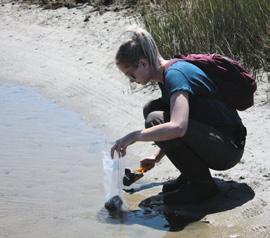
3 minute read
Fieldwork
Elizabeth Velliky collecting ochre samples in the area around Blombos.
The South African Animal Kingdom contains many animals that can be dangerous to humans. Snakes, scorpions and spiders are all encountered in the areas where we work. Before heading into the field in 2020, members of the excavation team attended a snake handling course in Cape Town. The course was both theoretical and practical, introducing us to species identification, behavior and habitat, before moving on to how different venoms work, how best to prevent dangerous encounters and what to do if bitten. We were then put to the test controlling, catching and securing live snakes for safe transport and re-release into the wild. Not only do snakes strike with lightning speed, but they can certainly move fast when they want to! The excavation season at Blombos Cave was planned for 11 – 30 March 2020. Staff, Postdocs, PhDs and Master students from UiB and Wits were to participate in excavating the 100 – 72-thousand-year-old (ka) levels. We prepared the site for excavation, which entailed, amongst other things, the removal of large rocks that were hindering planned expansion of excavations and installation of a state-of-the-art solar powered lighting system. Our goal for the field season was to excavate four quadrants down to the 100 ka layers, allowing a more detailed analysis of this level, and preparing the way for excavation of deeper layers in subsequent seasons. Unfortunately, after three days of excavation, we had to pack up the site and return home due to the outbreak of Covid-19.

Despite the short excavation season, a team of international scientists collaborating with SapienCE were able to visit Blombos Cave, including Ian Hall, Ellie Pryor, Aidan Starr (Cardiff University) and Jeroen van der Lubbe (Vrije Universiteit Amsterdam). This team had recently completed a successful cruise on the research vessel Marion Dufresne, partly funded by SapienCE, during which they collected several marine sediment cores from off the Agulhas bank. The cores contain records of Agulhas and South African hydroclimate variability during the timeframe studied by the centre and will be critical in our efforts to understand the nature of climatic changes experienced by our ancestors.
A field season was also planned at Klasies River main site from 2nd to 21st March, under the direction of Sarah Wurz. Students and staff from the University of the Witwatersrand, as well as the expert flint knapper, Christian Lepers from the University of Liège, Belgium, took part. This season focussed on re-opening the Witness baulk (an unexcavated portion of archaeological sediments left intact by previous excavators) and excavation of the earliest Middle Stone Age layers dating to ~110 ka. As at Blombos, fieldwork was cancelled due to Covid-19. Excavations stopped on 15th March and all participants returned home as soon as possible.

While the abrupt termination of excavations had negative repercussions for some planned material and data collection, we did successfully collect a variety of reference materials for several projects. This included Elizabeth Velliky and other team members surveying variety of geological outcrops and collecting ochre samples. The team visited several spectacular outcrops of ochre, including in the blistering hot Karoo landscape to the north of Riversdale. Samples from these sites will be used to try to determine where archaeological ochres present in Blombos Cave were collected.
We also made a good start on compiling a comprehensive modern comparative collection of non-food marine and estuarine shells, to compare with those found within archaeological sites. Shells were retrieved from nine different localities, ranging from the sandy beach to the west of Blombos Cave to the rocky fish traps in the Goukou estuary near Still Bay village to the east. Inèz Faul collected mud samples from the upper reaches of the Goukou river, to compare the ostracod species found there in the present day with those found in the Middle Stone Age layers at Klasies River main site.
Christopher Henshilwood giving a tour of Blombos Cave to Wits MSc students Alexandra Pearson and Inèz Faul.
An international team of scientists, including participants of the research cruise with Marion Dufresne, visited Blombos Cave in 2020.










